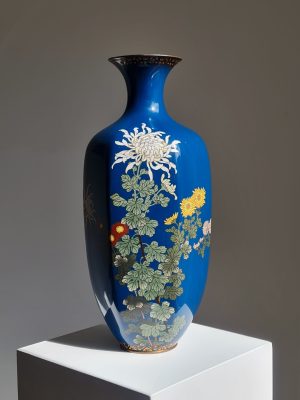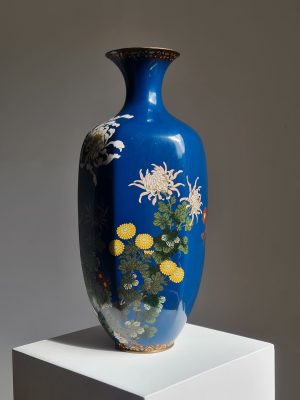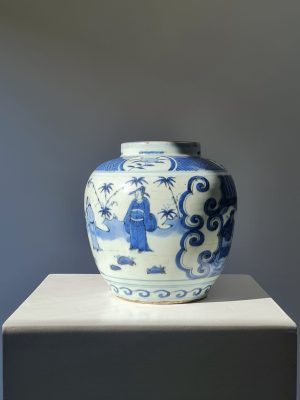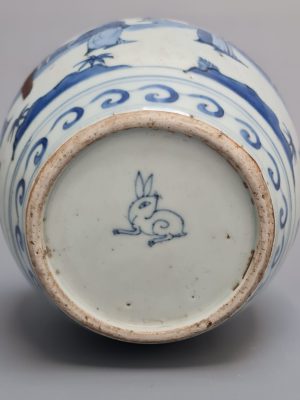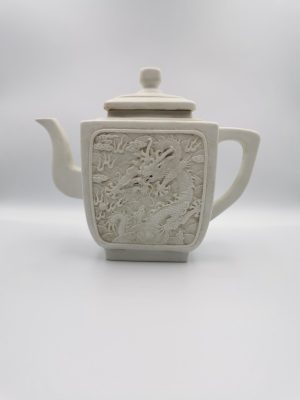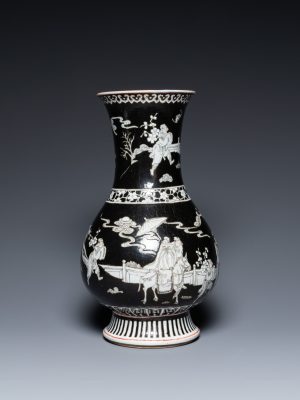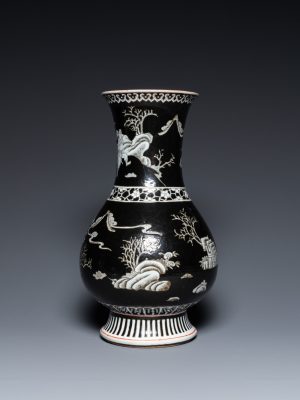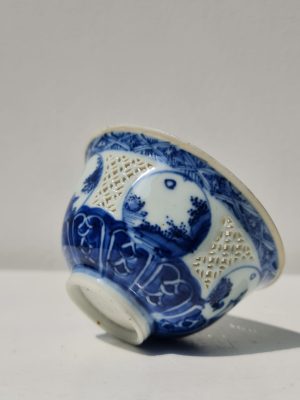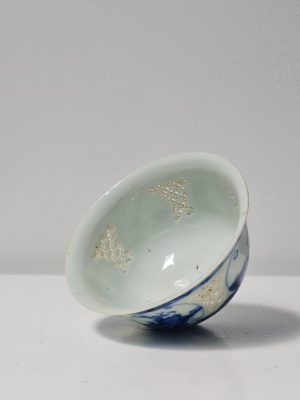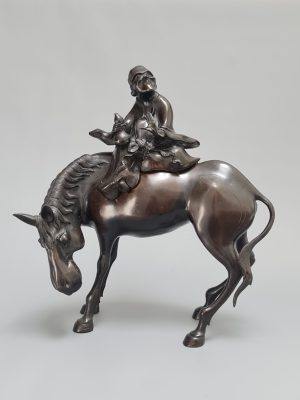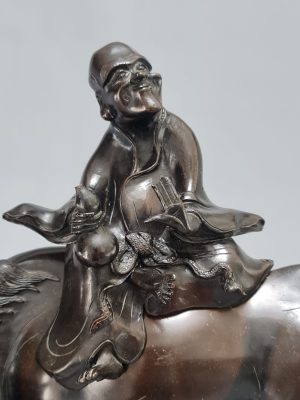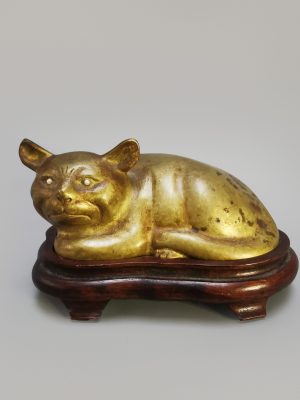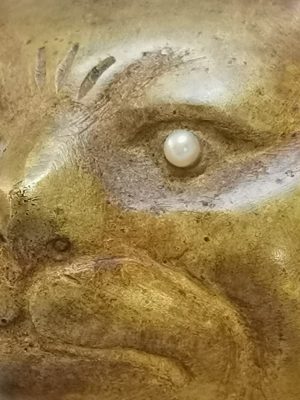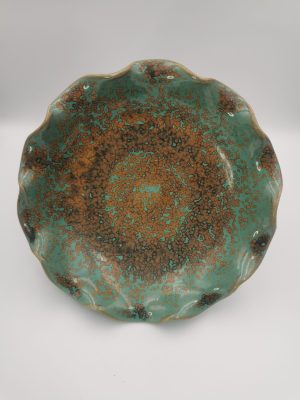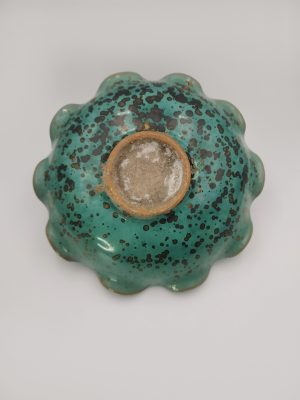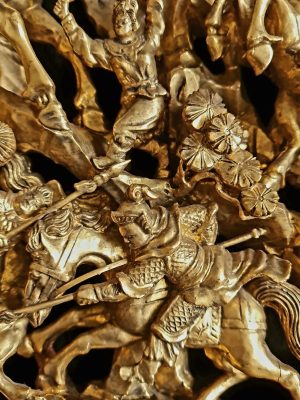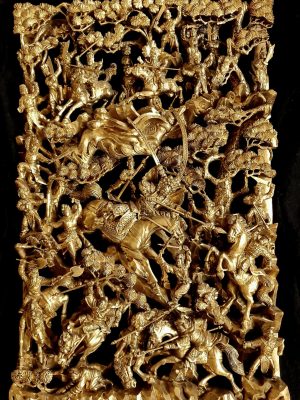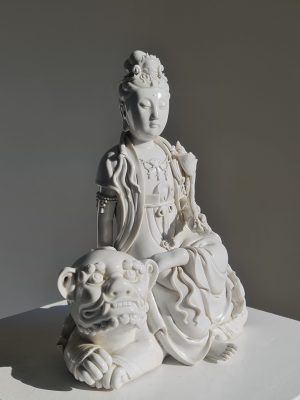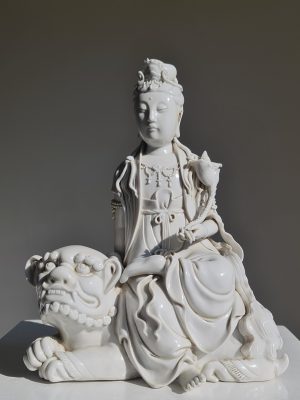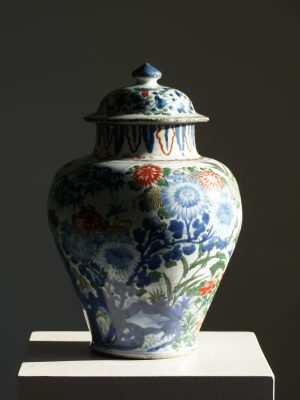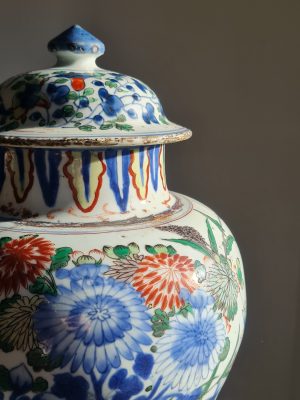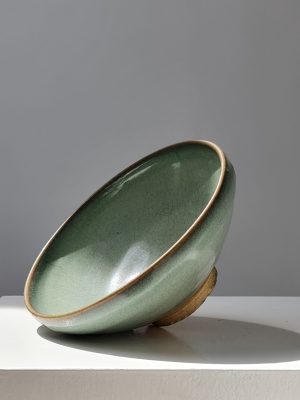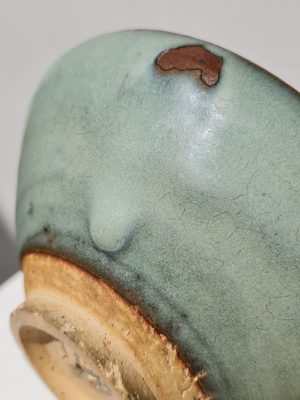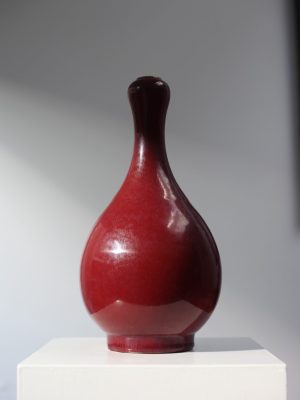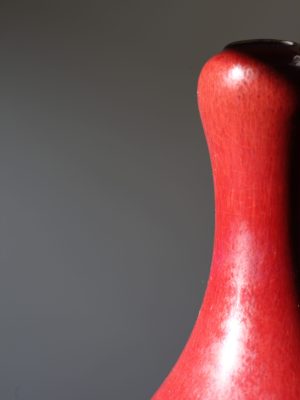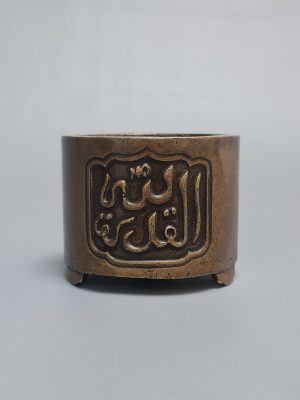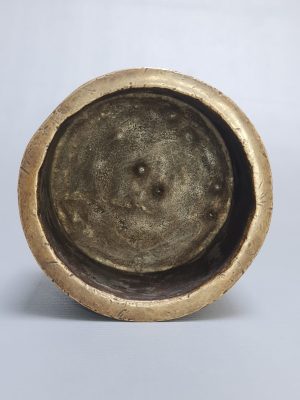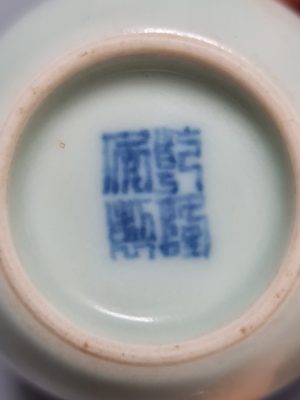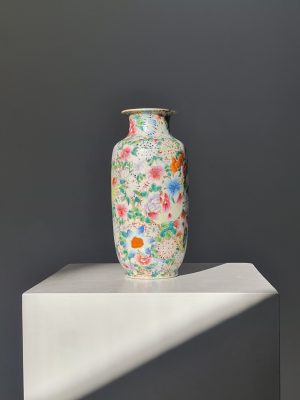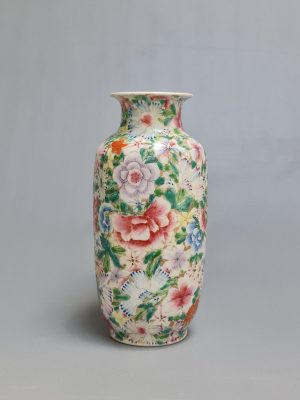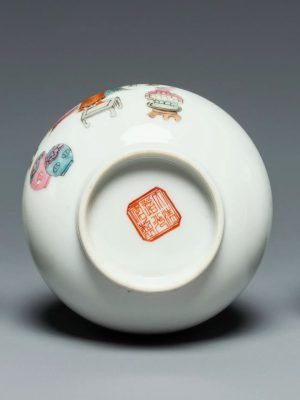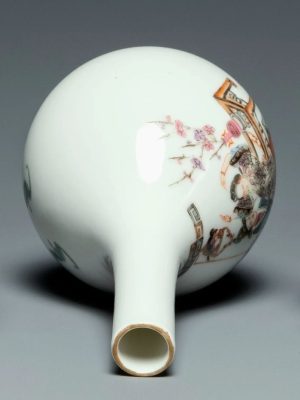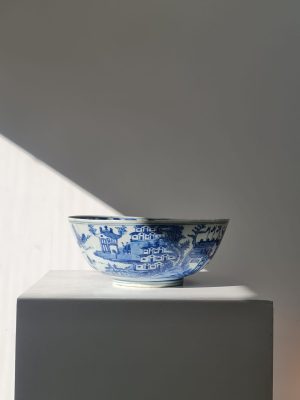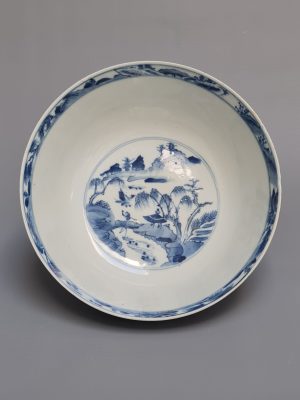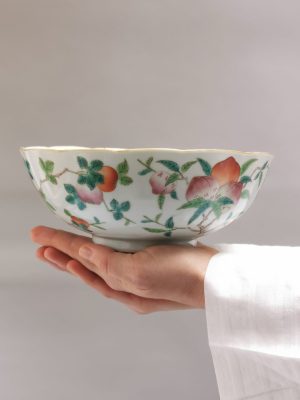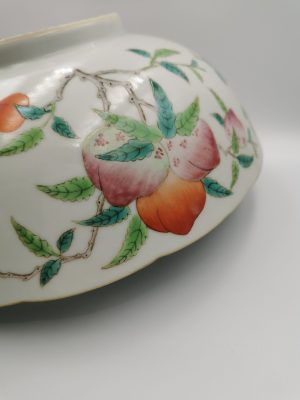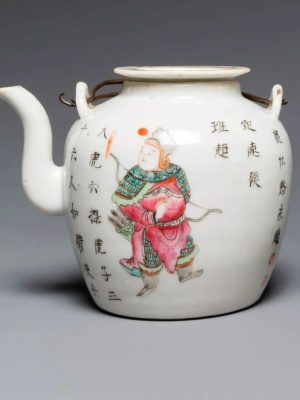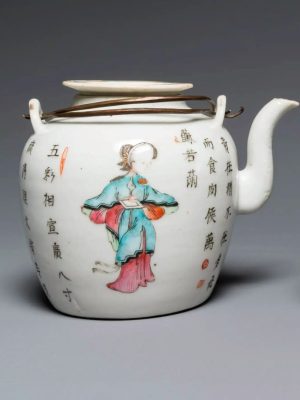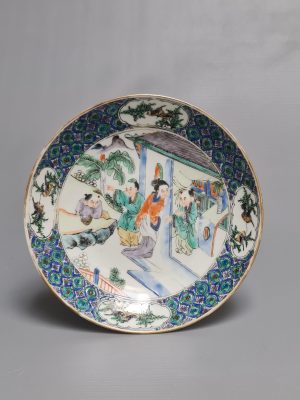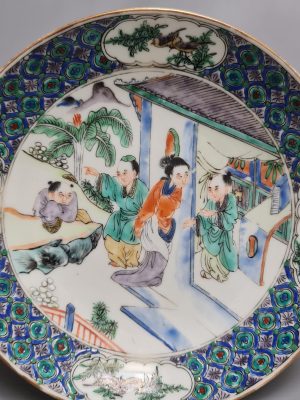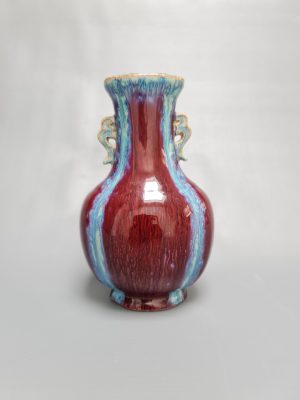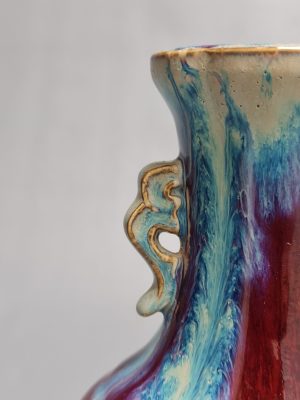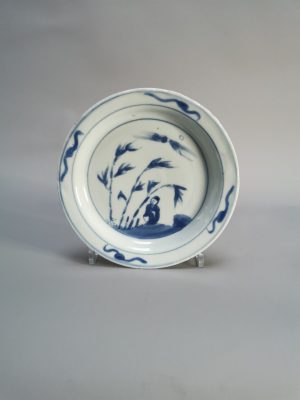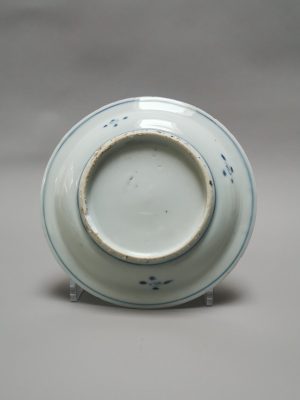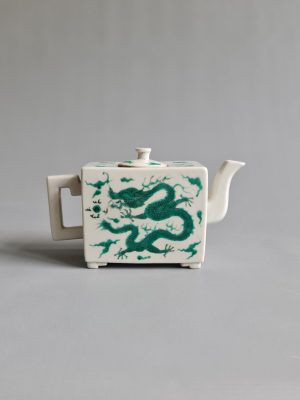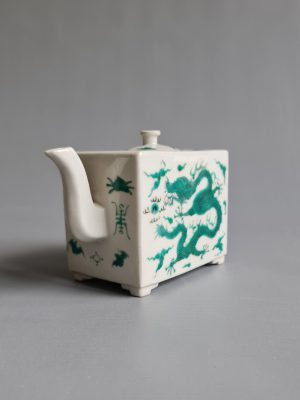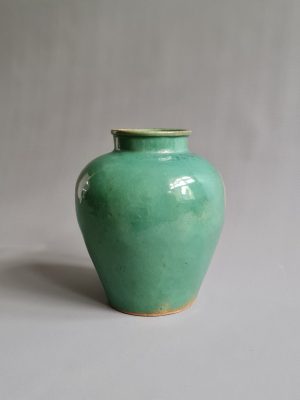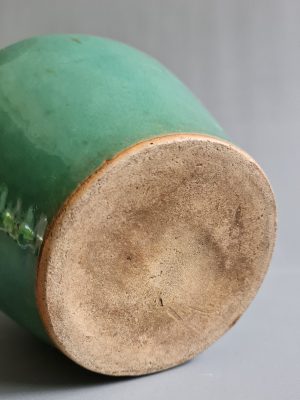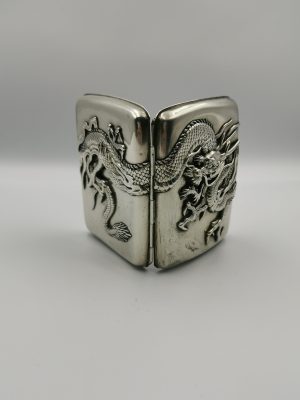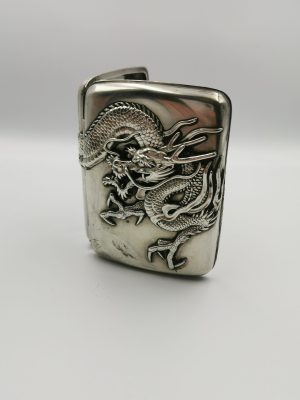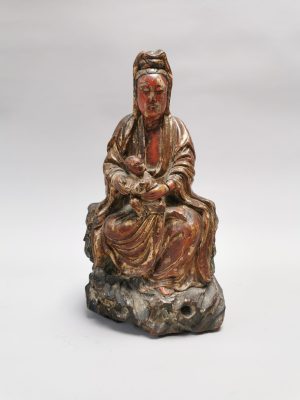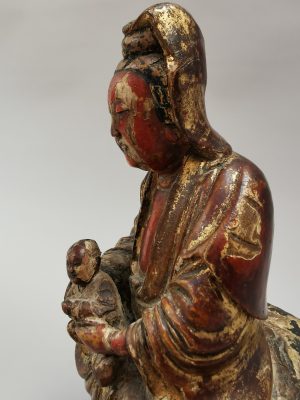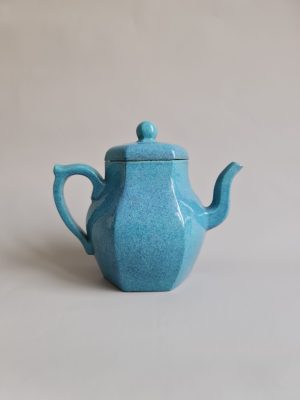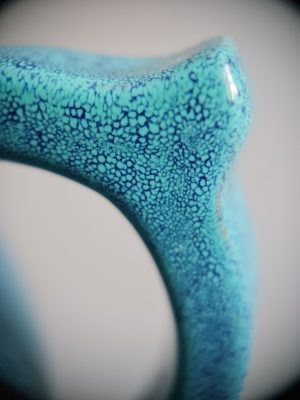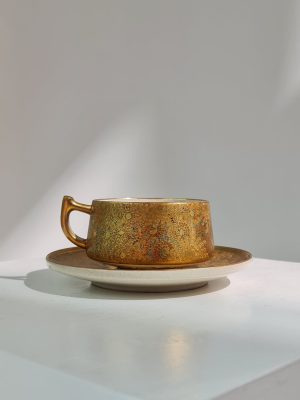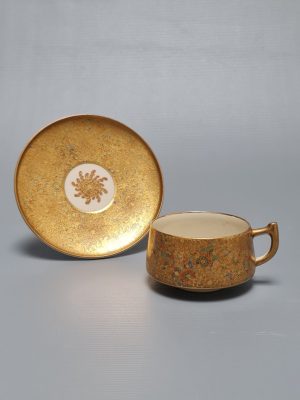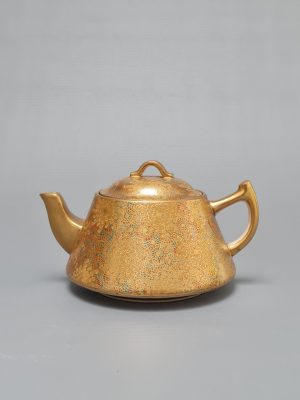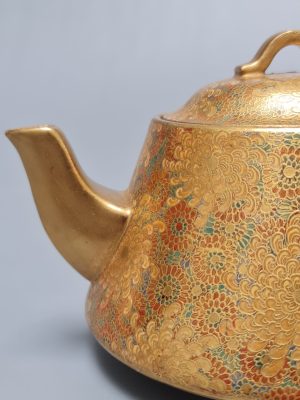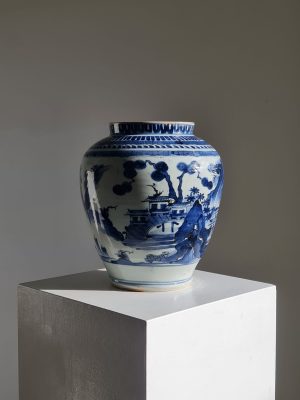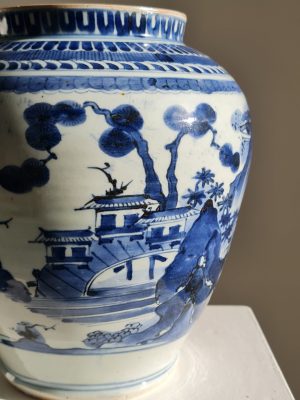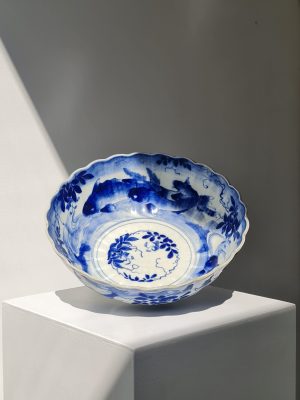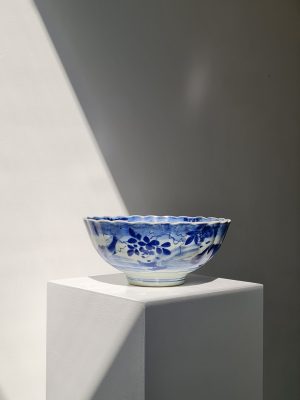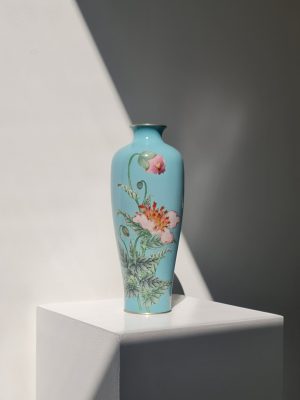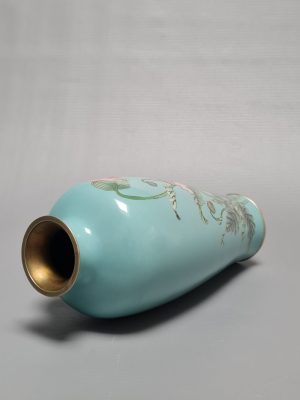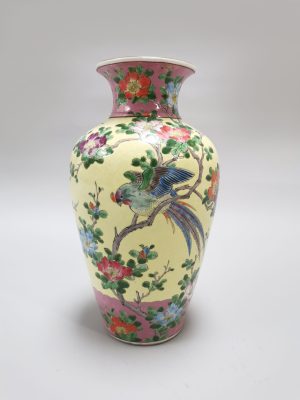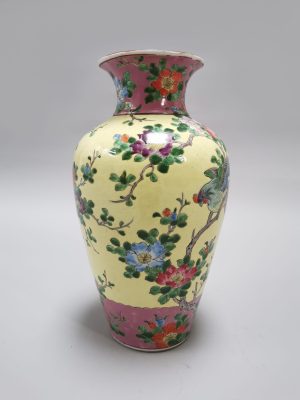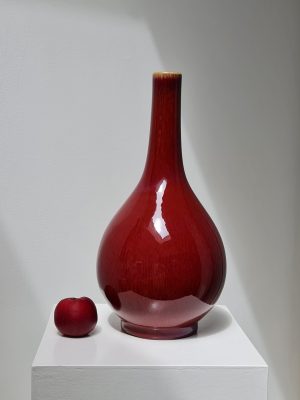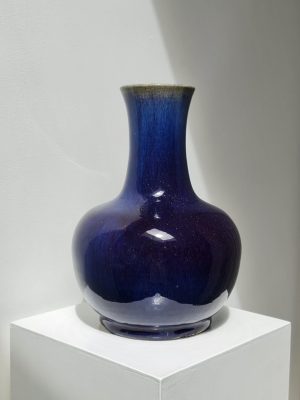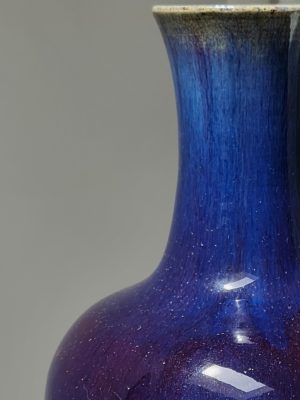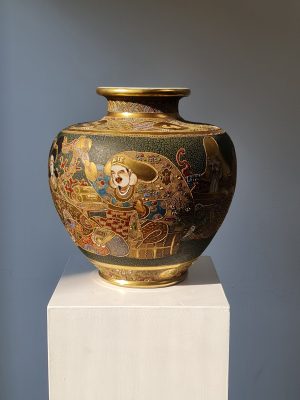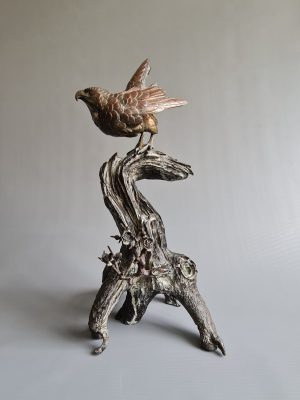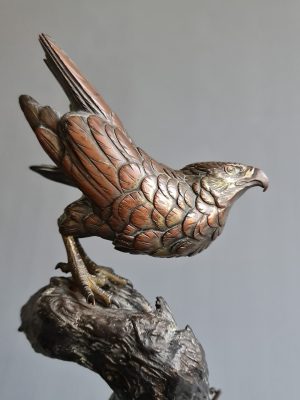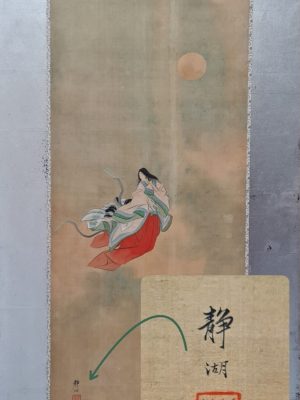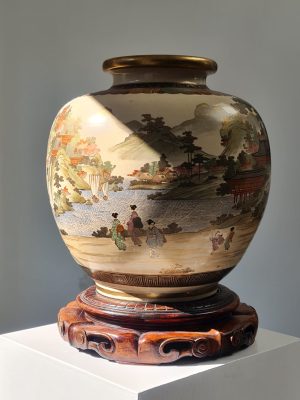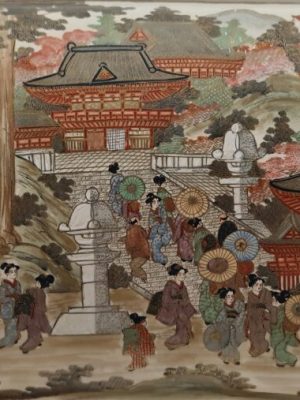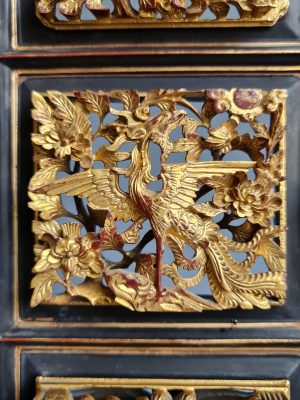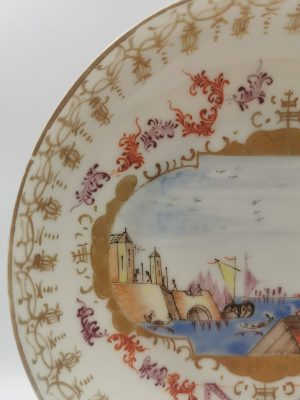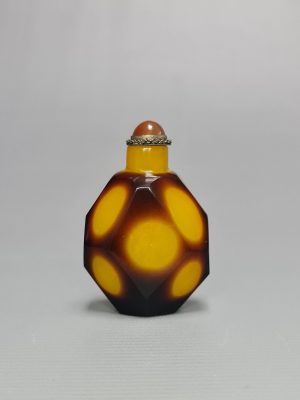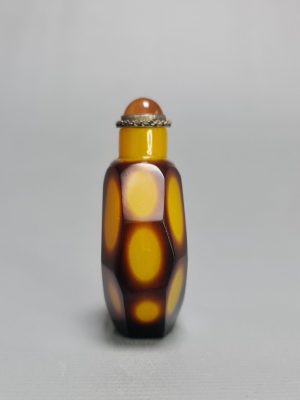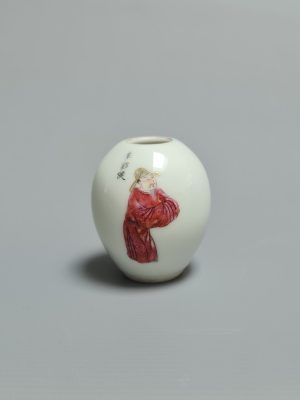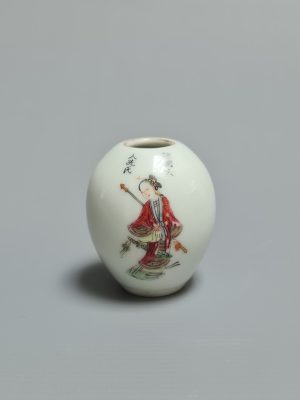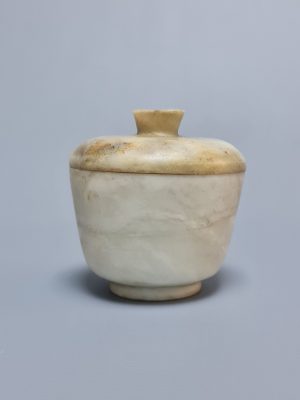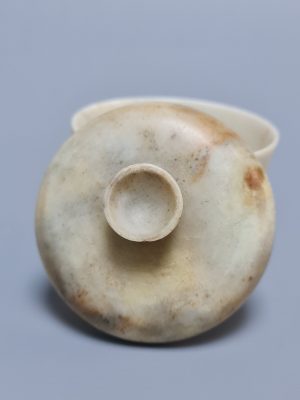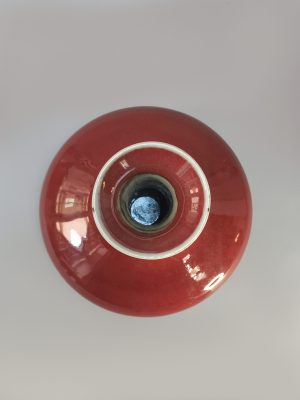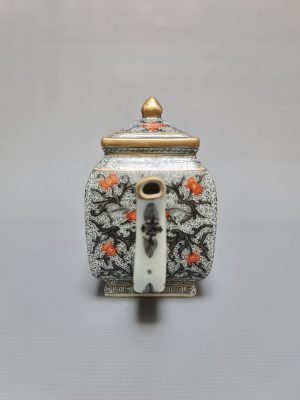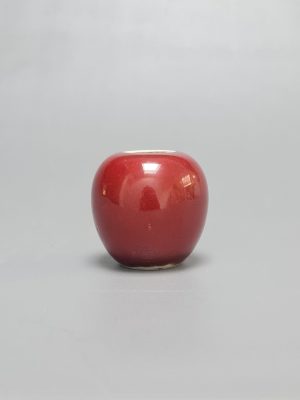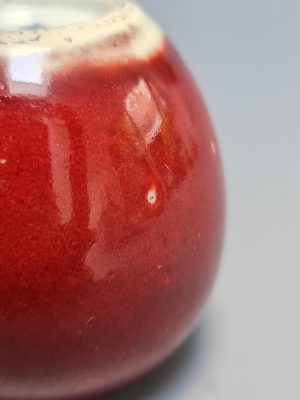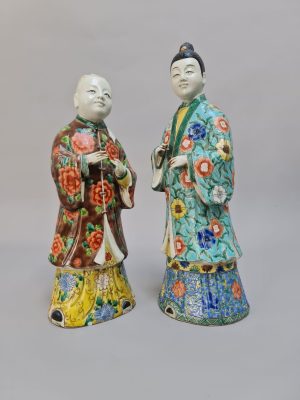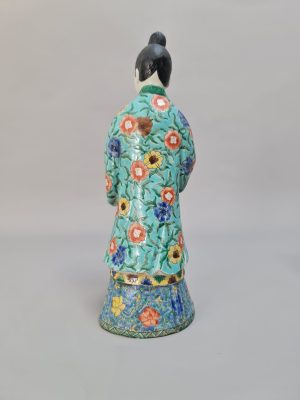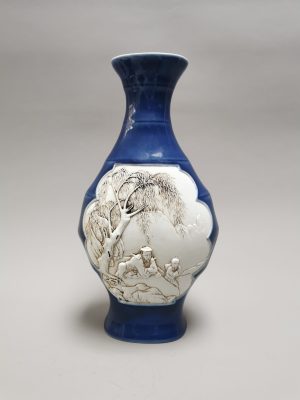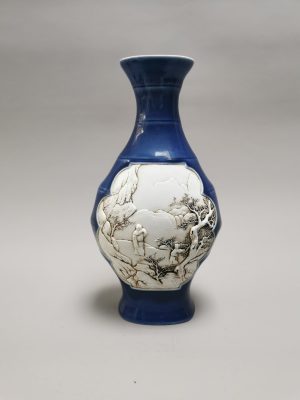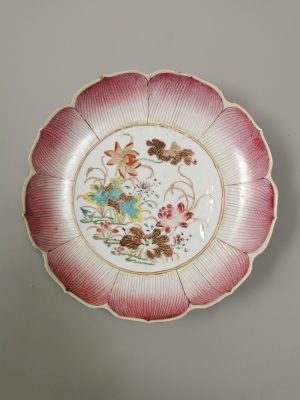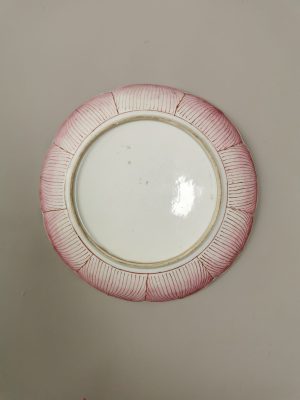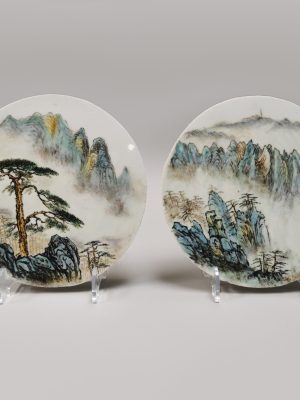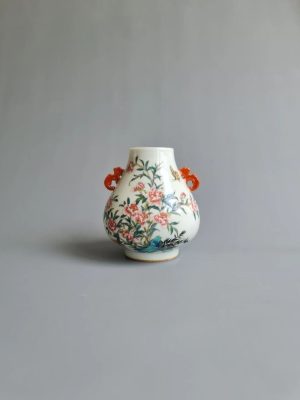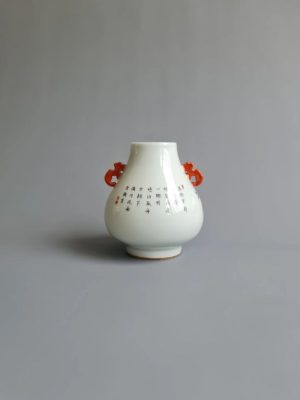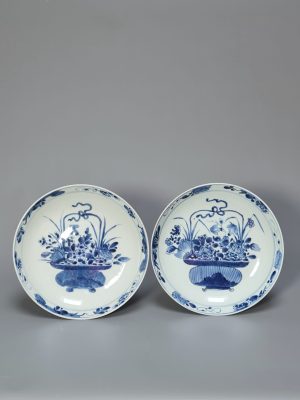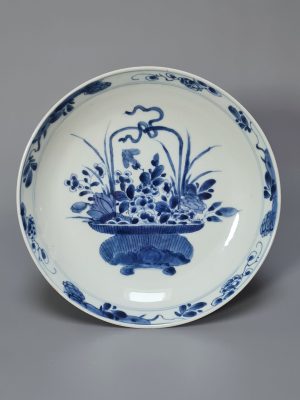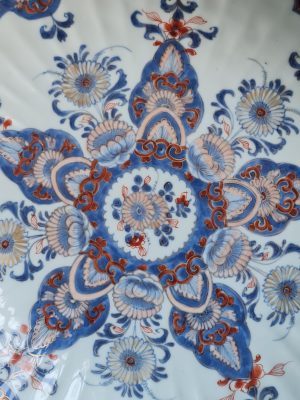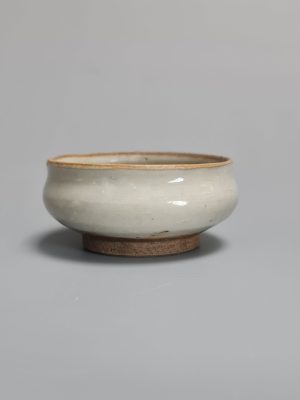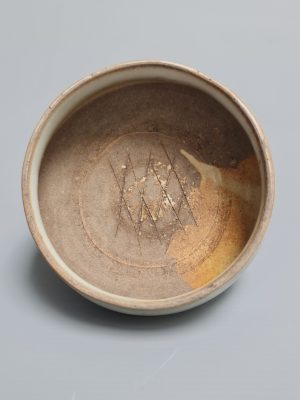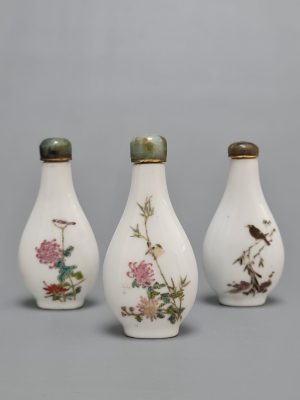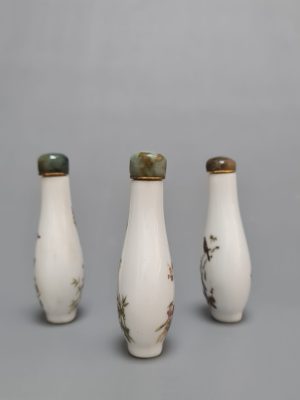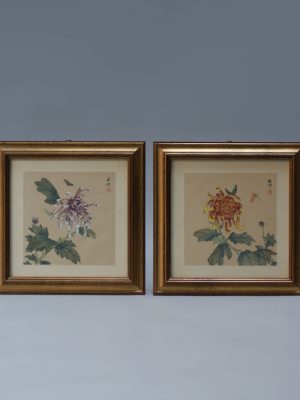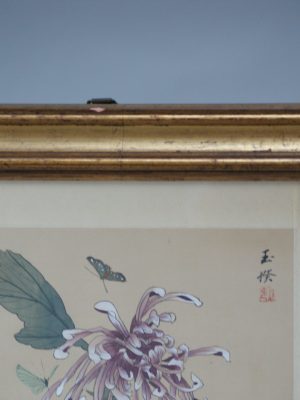-
- Niet op voorraad
- Sold lots
A blue-ground cloisonné enamel vase with floral decorations, Meiji period (1868-1912)
- During the Meiji period in Japan, which spanned from 1868 to 1912, there was a significant revival and transformation of traditional crafts, including cloisonné enamelware. This period marked Japan's modernization and increased exposure to Western artistic styles, leading to a synthesis of Western techniques with traditional Japanese aesthetics. Cloisonné, a technique involving the use of metal strips to create compartments…
- Lees verder
-
-
- Niet op voorraad
- Sold lots
A Chinese blue and white porcelain pot, Ming Dynasty, Wanli Period (1573-1619)
- During the Ming Dynasty's Wanli Period (1573-1619), blue and white porcelain production reached its zenith in China. The Wanli reign was characterized by a flourishing economy, expanding trade networks, and significant advancements in porcelain-making technology. Blue and white porcelain, featuring cobalt oxide painted under a clear glaze, became immensely popular both domestically and for export. This period saw the refinement…
- Lees verder
-
-
- Niet op voorraad
- Sold lots
A Chinese Biscuit porcelain teapot carved with dragons on both sides, late 19th century
- Chinese biscuit porcelain, also known as "biscuit-fired" or "unglazed" porcelain, refers to a type of ceramic ware that is fired at a high temperature without a glaze. This results in a matte or unglazed surface finish. Biscuit porcelain has been produced in China for centuries and has been used for various purposes, including teapots, vases, figurines, and other decorative items.…
- Lees verder
-
-
- Niet op voorraad
- Sold lots
A Chinese black-ground vase decorated in grisaille with a figure on horseback with attendants, 19th century
- Grisaille, a decorative technique using shades of gray, was popular during the late Qing Dynasty. This style allowed for intricate and detailed designs to be painted on porcelain vessels, creating a striking contrast against a dark background. The motif of a figure on horseback with attendants is a common theme found in Chinese art and literature, often symbolizing power, leadership,…
- Lees verder
-
-
- Niet op voorraad
- Sold lots
A Chinese blue and white openwork porcelain ‘Devil’s Work’ bowl, Chongzhen period (1627-1644)
- Amidst the bustling marketplaces of 17th-century China, during the Chongzhen period, there emerged an extraordinary openwork Linglong "Devil's Work" bowl. Legend spoke of a skilled artisan who dared to challenge the boundaries of artistry, crafting a bowl with such intricate openwork patterns that it was deemed the "Devil's Work." Each delicate cut and curve in the porcelain seemed to defy…
- Lees verder
-
-
- Niet op voorraad
- Sold lots
A Chinese bronze figure of a sage on a horse, Qing Dynasty
- Bronze figures depicting sages or immortals are a significant category in Chinese art, particularly during the Ming (1368–1644) and Qing (1644–1912) dynasties. These figures often represent revered historical or mythological characters, symbolizing wisdom, virtue, and moral values in Chinese culture. L i s t e d f o r a u c t i o n
- Lees verder
-
-
- Niet op voorraad
- Sold lots
A Chinese bronze gilded cat with pearl eyes on a wooden base, Early 20th century
- Bronze casting has a long history in China, dating back to ancient times, and was traditionally used to create ritual vessels, sculptures, and other decorative objects. The depiction of a cat, a symbol of good fortune and protection in Chinese culture, further enhances the significance of this sculpture. Cats were often depicted in Chinese art as guardians of the home…
- Lees verder
-
-
- Niet op voorraad
- Sold lots
A Chinese brush washer, oil-spotted celadon pottery, 19th century
- Oil-spot glaze, also known as "temmoku" or "tenmoku," is a type of glaze used in ceramic art that originated in ancient China. It is characterized by its rich, glossy surface with distinctive dark spots resembling drops of oil. These spots are created during the firing process when iron oxide in the glaze forms clusters or crystals, resulting in the unique…
- Lees verder
-
-
- Niet op voorraad
- Sold lots
A Chinese Carved Deep Relief Gilt Wood Panel Depicting Warrior Scenes
- In traditional Chinese art, depictions of warriors and battle scenes were common motifs that reflected the martial spirit, valor, and historical narratives of ancient China. These themes were often portrayed in various art forms, including paintings, sculptures, and carved panels like the one described. These carved gilt wood panels were highly valued in traditional Chinese art and were often used…
- Lees verder
-
-
- Niet op voorraad
- Sold lots
A Chinese Dehua figure of Manjushri seated on a lion, Qing Dynasty (1644-1911)
- The Chinese Dehua figure of Manjushri seated on a lion carries deep Buddhist meaning. Manjushri, the Bodhisattva of Wisdom, symbolizes knowledge and understanding, helping to remove ignorance. The lion she sits on represents strength, bravery, and the power of Buddhist teachings to overcome fear. On the back of the figure, there is a mark that reads "Bo Ji Yu Ren."…
- Lees verder
-
-
- Chinese Art
A Chinese floral and bird Wucai Lidded vase, Shunzi period (1644–1661)
- A Chinese floral and bird wucai lidded vase from the Shunzhi period (1644–1661) showcases vibrant overglaze enamel designs. This transitional piece reflects late Ming artistic influences, featuring intricate floral patterns symbolizing prosperity and birds representing harmony. Such vases exemplify the fine craftsmanship and decorative innovation of Shunzhi porcelain, which blended Ming traditions with emerging Qing aesthetic elements.
- Lees verder
-
- Niet op voorraad
- Sold lots
A Chinese Junyao Bowl, Yuan/Ming Dynasty (1279–1644)
- Junyao ware originated in Henan province and reached its height between the Song and Yuan dynasties, continuing into the early Ming. Celebrated for its thick, lustrous glazes, Junyao ceramics often display subtle variations in tone due to complex kiln firing. This bowl’s soft celadon-green glaze, without the more common purple splashes, represents a rarer and more understated expression of Junyao…
- Lees verder
-
-
- Niet op voorraad
- Sold lots
A Chinese large Garlic neck vase Coral red glaze , early 19th century
- During the Kangxi period (1662-1722), Chinese porcelain artisans created exquisite pieces like this plate, adorned with Imari decoration molded in lotus leaf form. Imari ware, originating from Japan but popularized in China during this period, featured vibrant colors and intricate designs. The lotus leaf motif, symbolizing purity and enlightenment in Chinese culture, adds a touch of elegance to the piece.…
- Lees verder
-
-
- Niet op voorraad
- Sold lots
A Chinese Ming tripod incense burner, Arabic-inscribed, Xuande marked
- The presence of Arabic inscriptions on a Chinese Ming tripod incense burner marked with the Xuande seal is a fascinating indication of the extensive trade and cultural exchanges that occurred during the Ming Dynasty (1368-1644) in China. During the Ming Dynasty, China experienced a period of economic prosperity and global trade expansion. Maritime trade routes, such as the famous maritime…
- Lees verder
-
-
- Niet op voorraad
- Sold lots
A Chinese pale green celadon water pot, Qianlong underglaze blue marked, early 19th century
- The production of celadon pottery, known for its pale green color and characteristic glaze, has a long history in Chinese ceramics. Celadon ware reached its peak during the Song Dynasty (960-1279) but continued to be produced and appreciated in later periods, including the Qing Dynasty. During the early 19th century, China experienced a period of cultural and artistic revival under…
- Lees verder
-
-
- Niet op voorraad
- Sold lots
A Chinese porcelain “Millefleurs” vase, Marked Guangxu
- During the late Qing Dynasty in China, particularly during the Guangxu reign (1875-1908), there was a resurgence of interest in traditional arts and crafts. This period saw a revival of various decorative techniques, including the popular "Millefleurs" style in porcelain production. The term "Millefleurs" translates to "thousand flowers" in French, and it refers to a decorative style characterized by densely…
- Lees verder
-
-
- Niet op voorraad
- Sold lots
A Chinese porcelain bottle vase depicting a romantic couple, bird, and interior scene. Overglaze red mark of Daoguang (1821-1850)
- During the Daoguang period (1821-1850) of the Qing Dynasty in China, porcelain production reached new heights of innovation and artistic expression. This era was characterized by a resurgence of traditional Chinese craftsmanship and a revival of classical themes in porcelain decoration. The Chinese porcelain bottle vase depicting a romantic couple, bird, and interior scene reflects the artistic trends of the…
- Lees verder
-
-
- Niet op voorraad
- Sold lots
A Chinese porcelain bowl depicting scenes of Jiangxi Province, dating from the 19th century
- Jiangxi Province, located in southeastern China, is renowned for its rich history, cultural heritage, and natural beauty. Throughout history, Jiangxi has been a center of cultural, economic, and political activity. It was the site of important events during the Ming and Qing dynasties, and it played a crucial role in shaping Chinese history. The scenes depicted on these bowls might…
- Lees verder
-
-
- Niet op voorraad
- Sold lots
A Chinese porcelain bowl with peach, Chenghua marked, Tongzhi period (1862-1874)
- During the Tongzhi period of the Qing Dynasty (1862-1874), there was a revival of interest in traditional Chinese art and culture. Porcelain production flourished, and artisans often looked to earlier dynastic periods, such as the Ming Dynasty, for inspiration. The mention of "Chenghua marked" indicates that the bowl bears a mark resembling that of the Chenghua Emperor, who ruled during…
- Lees verder
-
-
- Niet op voorraad
- Sold lots
A Chinese porcelain Famille Rose ‘Wu Shuang Pu’ teapot depicting ‘Cao E’ and ‘Ban Chao’, 19th century
- The Famille Rose technique, characterized by its delicate pink and rose-colored enamels, was widely popular during the 19th century. This style allowed artisans to create elaborate and colorful designs, making it particularly suitable for depicting narrative scenes and figures. The teapot depicting 'Cao E' and 'Ban Chao' is a testament to the rich cultural heritage of China during this period.…
- Lees verder
-
-
- Niet op voorraad
- Sold lots
A Chinese porcelain Famille Verte plate depicting a garden and shopping scene, Daoguang period (1821-1850)
- The term "Famille Verte" translates to "green family" in French, referring to the predominant use of green enamel alongside other colors. These plates typically feature intricate designs depicting various themes such as landscapes, figures, flora, and fauna. The decoration is applied over a white porcelain base and fired at high temperatures to create a durable and glossy finish. Famille Verte…
- Lees verder
-
-
- Niet op voorraad
- Sold lots
A Chinese porcelain flambé-glazed ‘hu’ vase, Qianlong mark
- Flambé glazing, characterized by its streaks of vibrant red and purple hues, was a popular technique during the Qing Dynasty. It involved firing the porcelain at high temperatures in a reducing atmosphere, resulting in the formation of unique and striking color variations on the surface of the vase. The 'Hu' shape vase holds significant cultural and historical importance in Chinese…
- Lees verder
-
-
- Niet op voorraad
- Sold lots
A Chinese porcelain plate featuring a lady with bamboo, dating to the Tianqi/Chongzhen period, approximately 1621-1644
- In Chinese culture, bamboo (竹, zhú) holds significant symbolism, often associated with longevity, resilience, and modesty. It is admired for its ability to bend without breaking, symbolizing flexibility and endurance in the face of adversity. The saying "竹子不老,秀色常青" (zhúzi bù lǎo, xiùsè chángqīng) translates to "Bamboo never ages; its beauty remains forever green," emphasizing its timeless and enduring nature. Furthermore,…
- Lees verder
-
-
- Niet op voorraad
- Sold lots
A Chinese porcelain teapot with a green dragon, marked Daoguang
- In Chinese culture, the dragon holds significant cultural and symbolic importance, representing power, strength, and good fortune. It is one of the most iconic and revered mythical creatures in Chinese mythology and folklore. Dragons are often depicted as long, serpentine creatures with scales, claws, and the ability to fly. Throughout Chinese history, the dragon has been associated with the emperor…
- Lees verder
-
-
- Niet op voorraad
- Sold lots
A Chinese red coral glazed vase depicting the image of a qilin, markerd Qianlong
- The Qianlong Emperor (1735-1796) of the Qing Dynasty was known for his appreciation of fine arts and his involvement in porcelain production. Under his reign, porcelain production reached new heights of quality and creativity. The coral red glaze, often referred to as "langyao" or "sacrificial red," was one of the distinctive glazes developed during this period. The depiction of a…
- Lees verder
-
-
- Niet op voorraad
- Sold lots
A Chinese Shiwan jar with celadon green glaze, Qing Dynasty
- Shiwan is a renowned ceramics-producing region located in Foshan, Guangdong Province, China. It has a long history of ceramic production dating back over 500 years. Shiwan ceramics are highly regarded for their exquisite craftsmanship, intricate designs, and unique glazes. The distinctive feature of Shiwan ceramics is their rich variety of glazes, which include celadon green, turquoise, blue, white, and various…
- Lees verder
-
-
- Niet op voorraad
- Sold lots
A Chinese silver cigarette case with dragon decoration from the late Qing dynasty
- Silver cigarette cases first appeared in China during the late Qing dynasty, which lasted from the mid-19th century to the early 20th century. During this time, there was an increasing demand for luxury items among the wealthy class, leading to the production of finely crafted silverware, including cigarette cases. These cases were often adorned with intricate designs and decorations, reflecting…
- Lees verder
-
-
- Niet op voorraad
- Sold lots
A Chinese Wooden Sculpture Guanyin “the Bringer of Sons”, 18th century
- 初 檀木雕送子觀音像 The most precious treasure in premodern China was a son to carry on the family legacy. Reflecting this fervently held wish, a new form of Guanyin emerged that presented the bodhisattva as a bestower of sons. This intimate sculpture, in which Guanyin cradles the hoped-for baby boy, would have been made for personal veneration by a wealthy devotee…
- Lees verder
-
-
- Niet op voorraad
- Sold lots
A Chinese Yixing clay teapot with a ‘Robin’s egg glaze’ and a seal mark of Dan Ran Zhai
- The history of Yixing clay teapots dates back centuries, with the Yixing region in Jiangsu Province, China, being renowned for its high-quality clay deposits. Yixing clay, also known as zisha clay, is prized for its unique properties, including its porous nature, which allows it to absorb and enhance the flavor of tea over time. The term 'Robin's egg glaze' refers…
- Lees verder
-
-
- Niet op voorraad
- Sold lots
A Famille Rose ‘Ten Views of Jiangxi Province’ plate, six-character seal mark in iron-red and of the Daoguang period (1821-1850)
- The "Ten Views of Jiangxi Province" theme originated from classical Chinese literature and poetry, where it was celebrated for its natural beauty, historical significance, and cultural importance. During the Qing Dynasty, particularly during the Daoguang period (1821-1850), the Famille Rose porcelain style flourished. This style, characterized by vibrant polychrome enamels, allowed artisans to create intricate and colorful designs that captured…
- Lees verder
-
-
- Niet op voorraad
- Sold lots
A Fine Japanese ceramic Satsuma tea cup and saucer with rich floral decoration, marked Kōzan 幸山, Meiji period (1868-1912)
- Satsuma ware refers to a style of Japanese pottery that originated in the Satsuma province during the late 16th century. Initially, Satsuma pottery was primarily simple and utilitarian in nature, but it later evolved into highly decorative and ornate pieces, particularly during the Meiji period (1868-1912). One distinctive feature of Satsuma ware is the use of richly colored enamels, often…
- Lees verder
-
-
- Niet op voorraad
- Sold lots
A Fine Japanese ceramic Satsuma teapot with rich floral decoration, marked Kōzan 幸山, Meiji period (1868-1912)
- Satsuma ware is a type of Japanese pottery known for its elaborate designs and fine craftsmanship. It originated in the late 16th century in southern Japan, specifically in the Satsuma region of Kyushu island. Initially, Satsuma pottery was primarily simple and utilitarian in nature, but it later evolved into highly decorative and ornate pieces, particularly during the Meiji period (1868-1912).…
- Lees verder
-
-
- Niet op voorraad
- Sold lots
A Japanese porcelain Arita vase with a blue and white design, 17th century
- Arita porcelain originated in the early 17th century in the town of Arita, located in the Saga Prefecture of Japan. A major influence on Arita porcelain was Chinese blue and white porcelain, which was highly prized and sought after in Japan during the 17th century. Japanese potters aimed to replicate the beauty and quality of Chinese porcelain while also incorporating…
- Lees verder
-
-
- Niet op voorraad
- Sold lots
A Japanese blue-white pleated porcelain bowl with a decor of carp and a botanical decor in the middle, 18th century
- During the 18th century in Japan, the production of porcelain bowls with intricate blue-white designs flourished. These bowls often depicted scenes from nature, reflecting the Japanese appreciation for the beauty of the natural world. Carp, known as koi in Japanese, were commonly featured in art due to their symbolic significance representing perseverance, strength, and good fortune. The botanical decorations in…
- Lees verder
-
-
- Niet op voorraad
- Sold lots
A Japanese cloisonné enamel vase with a blue-turquoise ground and floral decorations, created and signed by Jin-noe Ohta (1858–1907)
- The shosen technique used to create this vase is a refined cloisonné enamel method characterized by the application of fine silver wires to outline intricate patterns. The wires are carefully filled with vibrant enamel, resulting in a smooth, polished surface with exceptional detail. This technique flourished during the Meiji era (1868–1912), a period when Japanese art embraced innovation and international…
- Lees verder
-
-
- Niet op voorraad
- Sold lots
A Japanese porcelain vase with a rich colorful enamel exotic bird and flower scene, iron red marked, Early 20th century
- During the early 20th century, Japan experienced a period of cultural and artistic flourishing known as the "Taisho Era" (1912-1926). This era was marked by significant social, political, and artistic changes, reflecting Japan's transition into modernity while also preserving its rich cultural heritage. The vase in question, adorned with a rich and colorful enamel exotic bird and flower scene, exemplifies…
- Lees verder
-
-
- Niet op voorraad
- Sold lots
A large Flambé-Glazed Bottle Vase, 19th/20th Century
- An elegant bottle vase with ovoid body raised on a slightly spreading foot and tapering to a slender neck, covered with a crackle-suffused glaze of crushed strawberry tone and thinning to mushroom on the mouth rim. Height: 38 cm
- Lees verder
-
-
- Chinese Art
A large Flambé-Glazed Bottle Vase, Daoguang Period (1820–1850)
- Covered in a flambé glaze characteristic of Qing dynasty innovation, this vase features flowing shades of deep blue and purple with a cosmic, iridescent depth. The glaze was achieved through high-temperature reduction firing, creating unpredictable streaks and subtle crackles — a prized effect developed at the imperial kilns of Jingdezhen.
- Lees verder
-
- Niet op voorraad
- Sold lots
A large Japanese ceramic Satsuma vase depicting goddesses/immortals, 20th century
- The history of Satsuma ware, including Satsuma vases, traces back to the late 16th century in Japan. Originally, Satsuma pottery was produced in the Satsuma domain (present-day Kagoshima Prefecture) by Korean potters who were brought to Japan by Lord Shimazu during the late 16th century. These potters introduced their techniques, resulting in the creation of what would become known as…
- Lees verder
-
-
- Interior, Japanese Art
A large Japanese falcon perched on a branch, bronze sculpture (okimono), Meiji period (1868-1912)
- The hawk symbol in Japanese culture transcends mere representation; it embodies a profound and multifaceted narrative woven into the fabric of tradition and symbolism. Revered as a potent emblem of strength, power, nobility, and protection, the hawk's significance permeates various facets of Japanese society, history, and artistic expression. Dating back centuries, hawks have been intricately associated with the aristocracy and…
- Lees verder
-
- Interior, Japanese Art
A large Japanese folding screen with six watercolor paintings
- This is a Japanese multi-panel folding screen with six distinct painted panels, each showcasing traditional scenes of everyday life and landscapes. The artwork, rendered in soft colors, features figures, trees, and various outdoor activities, capturing a serene and nostalgic view of Japanese culture. This type of screen, often used as a room divider or decorative piece, reflects classic Japanese aesthetics…
- Lees verder
-
- Niet op voorraad
- Sold lots
A large Japanese Satsuma vase decorated with figural scenes from court life, Meiji period (1868–1912)
- This large Japanese ceramic Satsuma vase is a remarkable example of craftsmanship from the Meiji period (1868–1912), a time when Japan underwent significant political, cultural, and industrial transformation. The vase is adorned with intricate figural scenes from court life, which was a common subject in Meiji-period Satsuma ware. These scenes often depict noble figures, such as emperors, aristocrats, and samurai,…
- Lees verder
-
-
- Niet op voorraad
- Sold lots
A Pair of Antique Chinese Gilt Wood Carved Door Panels
- In traditional Chinese architecture, door panels were not merely functional elements but also served as intricate works of art. The process of creating gilt wood carved door panels involved skilled artisans who specialized in woodworking and carving techniques. They would start by selecting high-quality wood, such as cedar or rosewood, known for its durability and fine grain. The chosen wood…
- Lees verder
-
-
- Niet op voorraad
- Sold lots
A rare Chinese export porcelain cup and saucer, Yongzheng period (1722-1735)
- Decorated with pink and gold overglaze enamels, these pieces were crafted specifically for export to the West. The saucer features a central panel adorned with European figures amidst a harbor scene complete with European architecture. A gilded curled border frames the edge of the saucer. Similarly, the tea bowl is adorned with a complementary scene on its back. A comparable…
- Lees verder
-
-
- Niet op voorraad
- Sold lots
A rare Chinese faceted brown and yellow Beijing glass snuff bottle with an agate/silver stopper
- The history of Chinese faceted brown and yellow Beijing glass snuff bottles is intertwined with the tradition of snuff-taking and the artistry of glassmaking in China. During the Qing Dynasty (1644-1912), snuff-taking became popular among the Chinese elite as a social and recreational activity. Snuff bottles served as containers for powdered tobacco, and they were often made from various materials,…
- Lees verder
-
-
- Niet op voorraad
- Sold lots
A rare Chinese Famille Rose porcelain water pot, Daoguang marked and possibly from the period
- This rare Chinese Famille Rose porcelain water pot is a fine example of Qing Dynasty artistry, particularly from the 18th and early 19th centuries. Known for its soft, vibrant colors and intricate overglaze enamels, Famille Rose porcelain was highly prized by the imperial court. Marked with a Daoguang seal, this piece may have been created during the reign of Emperor…
- Lees verder
-
-
- Chinese Art
A rare Chinese hard stone (probably chicken bone jade) “gaiwan” covered tea bowl, 18/19 th century
- Sold at Rob Michiels in 2022 see link: https://www.rm-auctions.com/nl/aziatische-kunst-mei-2022/24190-een-chinese-hardstenen-gaiwan-dekselkom-18-19e-eeuw Originally used during the Ming Dynasty (1368-1644), the gaiwan, meaning "lidded bowl," emerged as a versatile vessel for brewing and drinking tea. Made from various materials such as porcelain, ceramic, and later, hard stone. The use of hard stone for crafting gaiwans became popular during the Qing Dynasty (1644-1912), particularly during…
- Lees verder
-
- Niet op voorraad
- Sold lots
A rare Chinese porcelain ‘Sang de Boeuf’ glaze vase, Yongzheng marked
- "Sang de Boeuf" is a French term that translates to "oxblood" in English. It refers to a distinctive glaze used in Chinese porcelain, characterized by its deep red color resembling the rich hue of ox blood. The glaze was developed during the Ming Dynasty (1368-1644) and reached its peak popularity during the Qing Dynasty (1644-1912). The process of achieving the…
- Lees verder
-
-
- Niet op voorraad
- Sold lots
A rare Chinese porcelain hand-painted teapot with a landscape scene and a red overglaze mark
- Hand-painted porcelain has been a hallmark of Chinese ceramics for centuries, showcasing the skill and creativity of the artisans who meticulously decorated each piece. Landscape scenes were a popular subject matter, often depicting serene natural landscapes, mountainous vistas, or idyllic countryside settings. Teapots have long been an essential part of Chinese culture, used not only for brewing and serving tea…
- Lees verder
-
-
- Niet op voorraad
- Sold lots
A rare Chinese porcelain ruby red water pot, Xuantong marked, period (1909-1912)
- The period of Xuantong, also known as the "Last Emperor," was a tumultuous time in Chinese history. Xuantong, whose reign lasted from 1909 to 1912, was the final ruler of the Qing Dynasty, which had ruled China for over two centuries. During the Xuantong period, China faced internal turmoil, including political instability, social unrest, and economic challenges. The Qing Dynasty…
- Lees verder
-
-
- Niet op voorraad
- Sold lots
A rare Chinese porcelain set of figures, Republic period (1912-1949)
- During the Republic period in China, spanning from 1912 to 1949, the country experienced significant political, social, and cultural transformations. This era marked the end of imperial rule and the establishment of a republican government, leading to a period of experimentation and innovation in various fields, including the arts. Chinese porcelain production during the Republic period was characterized by a…
- Lees verder
-
-
- Niet op voorraad
- Sold lots
A rare Chinese vase shaped like bamboo and carved with drawings on both sides
- This rare Chinese vase is crafted in the shape of bamboo, a symbol of endurance and longevity in Chinese culture. Intricately carved drawings adorn both sides of the vase, showcasing meticulous craftsmanship and attention to detail. The naturalistic depiction of bamboo and other motifs reflects traditional Chinese artistic sensibilities. With its elegant form and intricate carvings, this vase exemplifies the…
- Lees verder
-
-
- Niet op voorraad
- Sold lots
A rare large Famille Rose plate in the shape of a lotus flower, Yongzheng/Qianlong, 18th century
- The term "Famille Rose" refers to a style of Chinese porcelain decoration that emerged during the Qing Dynasty, particularly in the Yongzheng (1722-1735) and Qianlong (1736-1795) periods. Famille Rose, which translates to "pink family" in French, is characterized by its vibrant palette of enamel colors, including shades of pink, purple, green, and yellow. The lotus flower holds great symbolic significance…
- Lees verder
-
-
- Niet op voorraad
- Sold lots
A rare set of Chinese porcelain round Qianjiang Cai plaques hand-painted by artist 邹国钧 Zou Guojun (1913-1996), circa 1970
- Zou Guojun (邹国钧) was a renowned Chinese artist known for his expertise in the Qianjiang Cai (literally "thousand rivers and myriad mountains") style of painting. He was born in 1913 and passed away in 1996. Zou Guojun specialized in traditional Chinese painting, particularly in the meticulous and detailed Qianjiang Cai technique, which originated in the late Qing Dynasty and reached…
- Lees verder
-
-
- Niet op voorraad
- Sold lots
A small Famille Rose ‘hu’ vase with underglaze blue Qianlong mark, 18th century
- A small Famille Rose 'hu' vase with an underglaze blue Qianlong mark represents a remarkable example of Qing Dynasty porcelain craftsmanship. The "hu" shape, with its distinctive bulbous body and narrow neck. The Famille Rose decoration on the vase features delicate floral and figurative motifs rendered in vivid colors. This style was achieved using a combination of overglaze enamel colors,…
- Lees verder
-
-
- Niet op voorraad
- Sold lots
A Tibetan Ghau/Gau travel Shrine from Nepal
- The Tibetan Ghau or Gau travel shrine holds a rich history deeply rooted in Tibetan Buddhist tradition, with its origins tracing back to Nepal, a country known for its craftsmanship in religious artifacts. These portable shrines have been integral to Tibetan Buddhist practice for centuries, serving as personal sanctuaries for travelers and devotees. The Ghau/Gau travel shrine is typically a…
- Lees verder
-
-
- Chinese Art
Large Chinese export porcelain ‘Soldier’ vase decorated with 5 dragons, 20th century
- While the association between "soldier vase" and their sentinel-like appearance seems apparent, the term actually originates from a unique diplomatic transaction, highlighting the European nobility's admiration for Chinese luxury goods during the China Trade Period. Augustus the Strong of Saxony, whose reign spanned from 1694 to 1733, harbored an obsession for Chinese porcelain. In negotiations with Frederick the Great of Prussia…
- Lees verder
-
- Chinese Art
Pair of Chinese Blue and White Porcelain Dishes with Basket of Flowers Design, Kangxi Period (1662–1722)
- A stunning pair of Chinese blue and white porcelain dishes, each intricately decorated with a central basket of flowers motif surrounded by floral sprays. These dishes showcase the artistry of the Kangxi period (1662–1722), celebrated for its refined porcelain and elegant cobalt blue decoration. The finely painted details and balanced composition reflect the exceptional craftsmanship of early Qing Dynasty ceramics.…
- Lees verder
-
- Niet op voorraad
- Sold lots
Rare large Chinese porcelain plate with Imari decoration molded in lotus leaf form and highlighted with gilding, Kangxi period (1662-1722)
- During the Kangxi period (1662-1722), Chinese porcelain artisans created exquisite pieces like this plate, adorned with Imari decoration molded in lotus leaf form. Imari ware, originating from Japan but popularized in China during this period, featured vibrant colors and intricate designs. The lotus leaf motif, symbolizing purity and enlightenment in Chinese culture, adds a touch of elegance to the piece.…
- Lees verder
-
-
- Chinese Art
Small Chinese small bowl, Song Dynasty (960–1279)
- The Song Dynasty (960–1279) was a golden age for Chinese ceramics, marked by its technical advancements and refined aesthetic. This period saw the rise of simple, elegant designs that highlighted natural beauty, often with muted glazes in shades like celadon, white, or light blue. Song potters valued subtlety and form over elaborate decoration, focusing on creating graceful, harmonious shapes. Bowls…
- Lees verder
-
- Niet op voorraad
- Sold lots
Three Chinese Famille Rose porcelain snuff bottles with green stone stoppers, featuring floral and bird motifs on both sides.
- Porcelain snuff bottles have a rich history that dates back to imperial China, where they were primarily used during the Qing Dynasty (1644-1912). These small vessels, typically crafted from porcelain but also made from other materials like glass, jade, and metal, were used to hold powdered tobacco, or snuff, which was inhaled through the nostrils. The use of snuff, introduced…
- Lees verder
-
-
- Niet op voorraad
- Sold lots
Two Floral Chinese paintings on silk , half 20th century
- Chinese artists have long valued silk for its ability to absorb and retain ink and pigments, resulting in rich and nuanced colors that are prized in traditional Chinese painting. The smooth surface of silk also allows for fine detailing and subtle shading, enabling artists to create intricate landscapes, figures, flowers, and other subjects with remarkable delicacy and precision. Floral motifs…
- Lees verder
-
Winkelen
Dit is waar je door producten in deze winkel kunt bladeren.

